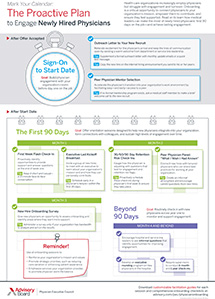Auto logout in seconds.
Continue LogoutU.S. News & World Report on Monday released its annual Best Medical Schools ranking, which include separate lists recognizing leading schools for research, primary care, and each of eight specialties.
Your physician recruitment toolkit: How to successfully attract and onboard new physicians
To determine the research and primary care rankings, U.S. News in fall 2018 and early 2019 surveyed 185 accredited medical and osteopathic schools in the United States. Of the schools surveyed, 120 responded with the data needed for inclusion in the rankings.
Methodology for research rankings
For the research rankings, U.S. News assessed each school's performance based on a weighted average of the following indicators:
- Quality assessment, including assessment scores on a five-point scale from medical and osteopathic school deans, deans of academic affairs, and heads of internal medicine or directors of admissions, as well as assessment scores by residency directors;
- Research activity, including total dollar amounts of NIH research grants and dollar amounts of NIH research grants awarded per total full-time faculty members;
- Student selectivity, including median MCAT scores, median undergraduate GPA, and acceptance rate; and
- Faculty-to-student ratios.
Last year, U.S. News included measures of non-NIH funded research in their methodology. However, this year, U.S. News exclusively used NIH funding on the recommendation of medical school deans.
Harvard University tops the research list
The top 10 medical schools for research (including some ties), according to U.S. News, were:
1. Harvard University (Cambridge, Massachusetts);
2. Johns Hopkins University (Baltimore);
3. Stanford University (Stanford, California);
3. University of Pennsylvania (Philadelphia);
5. University of California—San Francisco (San Francisco);
6. Columbia University (New York);
6. University of California—Los Angeles (Los Angeles);
8. Washington University in St. Louis (St. Louis);
9. Cornell University (New York);
9. Mayo Clinic School of Medicine (Rochester, Minnesota); and
9. New York University (New York).
Click here to view the full list.
University of North Carolina tops the primary care list
For the primary care rankings, U.S. News assessed each school's performance on a weighted average of the following indicators:
- Primary care rate, including the percentage of a school's M.D. or D.O. graduates entering primary care residencies averaged over 2016, 2017, 2018;
- Two quality assessment scores;
- Student selectivity, including median MCAT scores, median undergraduate GPA, and acceptance rate; and
- Faculty-to-student ratios.
The top 10 medical schools for primary care (including some ties) were:
1. University of North Carolina—Chapel Hill (Chapel Hill, North Carolina);
2. University of Washington (Seattle);
3. University of California—San Francisco (San Francisco);
4. Baylor College of Medicine (Houston);
5. University of California—Los Angeles (Los Angeles);
6. Oregon Health and Science University (Portland, Oregon);
6. University of Michigan—Ann Arbor (Ann Arbor, Michigan);
8. University of Nebraska Medical Center (Omaha, Nebraska);
9. University of California—Davis (Sacramento, California);
10. University of Minnesota (Minneapolis); and
10. University of Pennsylvania (Philadelphia).
Click here to view the full list.
Best schools for eight specialties
U.S. News also ranked hospitals within eight medical specialties. These rankings were based on ratings by medical school deans and senior faculty from the 120 responding schools. Respondents were asked to identify up to 15 schools offering the best programs in each specialty.
This year, U.S. News included family medicine as a specialty ranking after a one-year hiatus "based on recommendations from experts in the field that it's one of the major curriculum areas taught at medical schools."
Here is the list of the top school in each specialty:
- Anesthesiology: Johns Hopkins University;
- Family medicine: Oregon Health and Science University;
- Internal medicine: Johns Hopkins University;
- OB-GYN: Harvard University;
- Pediatrics: University of Pennsylvania;
- Psychiatry: Harvard University;
- Radiology: A tie between Harvard University and Johns Hopkins University; and
- Surgery: Johns Hopkins University (U.S. News & World Report research rankings, 3/11; U.S. News & World Report primary care rankings, 3/11; U.S. News & World Report methodology, 3/11).
Win the war for physician talent
Physician recruitment is not a new problem. But generational changes and rising expectations for physician performance make competition for physician talent feel increasingly intense today.
Though recruitment challenges are deep-rooted, organizations can take steps to ensure their physician recruiting process is as effective as possible. Read the report to learn the four requirements for successful recruitment in today’s competitive market.
Don't miss out on the latest Advisory Board insights
Create your free account to access 1 resource, including the latest research and webinars.
Want access without creating an account?
You have 1 free members-only resource remaining this month.
1 free members-only resources remaining
1 free members-only resources remaining
You've reached your limit of free insights
Become a member to access all of Advisory Board's resources, events, and experts
Never miss out on the latest innovative health care content tailored to you.
Benefits include:
You've reached your limit of free insights
Become a member to access all of Advisory Board's resources, events, and experts
Never miss out on the latest innovative health care content tailored to you.
Benefits include:
This content is available through your Curated Research partnership with Advisory Board. Click on ‘view this resource’ to read the full piece
Email ask@advisory.com to learn more
Click on ‘Become a Member’ to learn about the benefits of a Full-Access partnership with Advisory Board
Never miss out on the latest innovative health care content tailored to you.
Benefits Include:
This is for members only. Learn more.
Click on ‘Become a Member’ to learn about the benefits of a Full-Access partnership with Advisory Board
Never miss out on the latest innovative health care content tailored to you.



